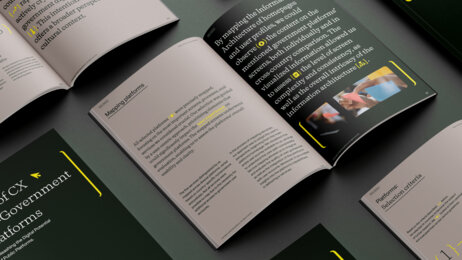
Sonia Przybył
-
Dec 23, 2024
-
14 min read
Before we start, to get the most out of this article, we recommend you check out our article on Customer Experience and why it matters.
To begin our main topic, we would like to share some numbers. Our digital world is constantly evolving, and each year, more mobile apps and websites are being launched. Also, more and more companies decide to move to the digital world with their products or services. It all escalated so quickly that in 2024, the number of apps available surpasses 5.000 million, and on the web alone, you can visit approximately 1.13 billion websites (good luck with that)!
Getting back to the customer experience (CX) – it is one of the most crucial aspects when developing a digital solution. And it doesn’t matter if it will be business-related or not. However, to properly take care of customer experience in your product, it is important to consider not only here and now but also to be ready for the future. But nobody knows what is going to happen in the future, right? That is precisely where trends can help you. Well, to be more specific, analysing trends can help in predicting the future.
What is a trend, and why is it so important?
It may sound like a trivial question. Trust us, it is not. This is simply because the popular understanding of the word “trend” may be different from the actual, more academic perspective.
A trend is a directional process of change indicated or determined by signals or symptoms of change.So, let’s explore together what the future holds for digital customer experience, shall we?
Customer experience (CX) trends to watch in upcoming years
When discussing the future of digital customer experience, we must mention that trends will drive those changes. Here, we will discuss the three most crucial trends changing how we comprehend customer experience and customer expectations.
Self-regulating perfections
Most people probably dreamt of living forever at least once or just thought about this idea. Have you? Well, we already know that it is impossible. And our first trend is similar to the whole concept of living forever. However, since the trend can not be about something impossible to achieve, it is actually about the second-best thing – longevity. That is something we can most definitely achieve. Moreover, due to demographic changes, prolonging one’s life has become more actionable than a healthy diet or regular exercise.
In such a context, self-regulating perfections refer to a well-known idea of development (in biological terms) and the redefinition of health (its perception, form, quality, and all related, even superhuman artefacts).
When discussing a trend, it is crucial to consider the reason behind its beginning. Here, with self-regulating perfections, we have to mention some statistics from the Central Statistical Office (GUS). It says that by 2050, Europe’s population aged 60 and above will account for nearly 40% (an estimated ratio of 161 million to 236 million), with over 10% of Europeans being over 80 years old. Pretty scary, isn't it?
Going further, an ageing society entails not only demographic changes but also shifts in healthcare, both on a public and private level. Such changes are linked to potential improvements in the quality and length of life, enhanced personalised preventive care, and solutions to problems related to the geriatric care deficit.
Forecasts – Life monitoring
As mentioned earlier, we have to go back in time, but just for a little while. The COVID-19 pandemic drew attention to remote health monitoring, supported by wearable technologies and genetic and genomic testing. This situation can improve the public health information system by providing data on the population's health. Collecting genetic data, on the other hand, can offer personalised health insights for individuals to monitor their well-being.
Implementing mass-scale changes in life monitoring would build awareness of self-observation habits and prevention.
Forecasts – Self-improvement
After monitoring and preventive diagnostics, the next step is to maintain a high quality of life-extending survivability at the population level. That is precisely what self-improvement is.
It involves creating xenobots, programmable life forms made from African clawed frog cells. These xenobots could help detect diseases early and provide necessary vitamins and minerals, potentially extending the human lifespan. While still speculative and futuristic, xenobots represent a step towards continuously repairing the human body and getting closer to the idea of living forever.
Zero trust
Here, we will discuss a hot topic recently—cybersecurity. Remember the worldwide drama with Mark Zuckerberg and Facebook? In 2021, Facebook saw the data of over 530 million users compromised. That is why we need this trend. Zero trust is driven by the need for robust data protection amidst rising breaches, which hit 878.17 million records globally. Recent high-profile hacks on giants like Facebook, Microsoft, and Twitter underscore the urgency of adopting Zero Trust in cybersecurity.
The European Commission provided information regarding the losses associated with cyber-attacks in 2020, which amounted to 5.5 trillion euros. That’s twice as much as five years earlier. Both public and private sectors have now initiated campaigns and actions aimed at redesigning current data structures to increase cybersecurity awareness, along with compliance with political regulations.
Forecasts – Personal verification
User authentication is increasingly popular because it is safe and protects personal information. Biometric methods, like behavioral biometrics, use parameters such as writing style and movement habits to recognize users.
This refers to a personalised form of consumer authentication, which can help limit misuse of personal data due to the difficulty of "forging" psycho-physical behavioural elements. Behavioural biometrics can also expand databases and shape new profiling segments by mapping mood changes and influencing customer decisions during consumer activities.
Forecasts – Cyber-resilience
Big organisations need more than personal verification to protect internal and external data. They will need to adopt new technologies that are currently not used. This implementation may involve the rise in popularity of dual authentication systems and the security of endpoints or Wi-Fi networks.
Due to this trend, global regulatory structures will strengthen, legal regulations will accelerate, and organizations will focus on building trust architecture and implementing quantum encryption for enhanced data security.
Glass box
Have you ever wondered what the company you like looks like inside? Well, in the past, companies were black boxes. So, from the outside, it was nearly impossible to tell what was hidden inside. The brand was painted outside the box, but the truth was hidden behind an impenetrable wall. Fortunately, those times ended, and today, the trend is different.
Nowadays, organisations are transforming into glass boxes. Now, anyone can look inside and see the people and culture. This direction is not new. It was shaped over many years, primarily referring to the impact of public and private organisations on internal and external reality. The overarching value of this change is transparency.
Information from the European Commission indicates that digital technologies account for 8-10% of energy consumption and 2-4% of greenhouse gas emissions. From a global perspective, these may not be significant percentage shares, but they still represent large absolute amounts.
Forecasts – Systemic Design
The direction of systemic design in design thinking is seen as a design process in which we pay attention to the sought-after solution and the entire ecosystem.
In this direction, we consider the whole as a crucial value, and the perspective of responsibility for the developed solution is taken into account, considering:
- Different stakeholder groups and users.
- The operating system, technology, etc.
Designing with the whole system in mind influences the trend towards mass inclusiveness and digital inclusiveness.
Forecasts – Sustainable Optimisation
After describing the systemic design, we will now focus on the multidimensional design. It is a main part of sustainable optimisation and is linked to ongoing data collection and a deep understanding of the environment and its users. Hence, the optimisation of digital products aims to map user needs by maintaining a constant relationship with them regarding information and artefacts.
This approach allows design changes that address specific needs without unnecessary design overproduction.
The team behind this data
This entire article would not have been possible without our outstanding research team, which compiled an exceptional report, “Direction of Change in Digital Customer Experience – 2025 Trends.” Specifically, this report was prepared by:
- Sonia Przybył – Sociology graduate from the University of Adam Mickiewicz, pursuing a PhD in trend analysis and forecasting. Teaching at universities since 2018 and associated with Flying Bisons as the research team leader and mentor at the Flying Bisons Academy since 2022.
- Kamila Rodzinka – A Psychology graduate from Jagiellonian University, she has conducted research and usability tests for renowned brands across various industries. Since 2020, she has been part of Flying Bisons, specialising in research, diagnosing user expectations, and shaping product changes.
- Jakub Stróżyk – Jakub has a bachelor's degree in Cognitive Science and a master's degree in Creative Management. He specialises in user research and analysis at Flying Bisons, focusing on understanding user behaviours to ensure satisfaction with digital products.
Download the full report
We would like to encourage you to visit our dedicated page to download the full version of the report. There is a wealth of knowledge you can benefit from, so don't hesitate! To learn more about trends and discover how you can implement them in your organisation, download the full report now.
Also, this isn't the last report on trends we plan to launch. This type of report will be released every year, and this is the first in the series.
If you need support in research and development to create new solutions or change current products and services, please feel free to send us a message! Our team is ready to help you unleash your digital potential and create a similar trendbook!
Furthermore, if you want to advance your knowledge about trends even more, we are also a partner of postgraduate studies at Collegium da Vinci—Forecasting and Implementation of Trends.




















